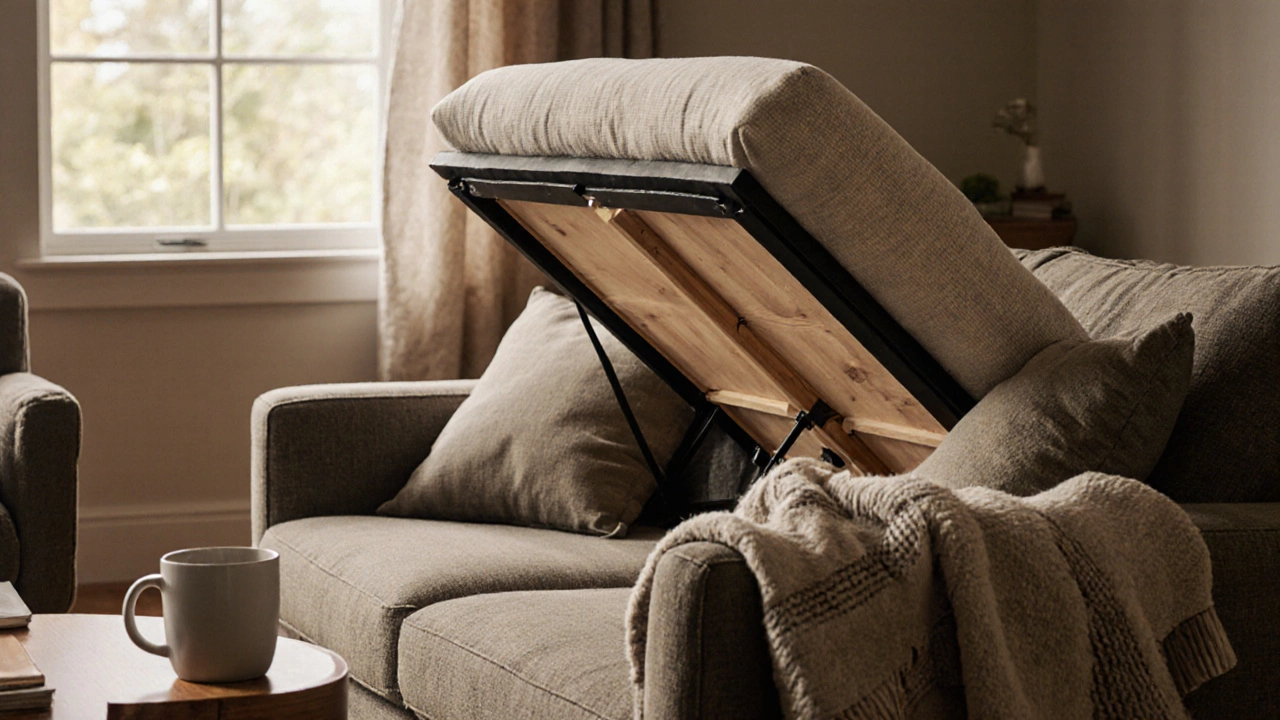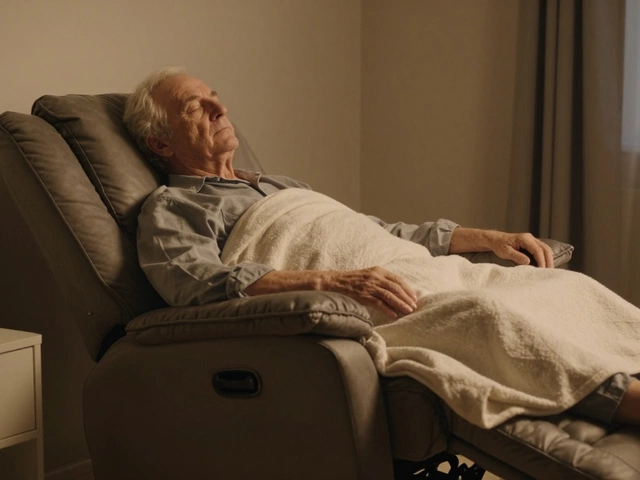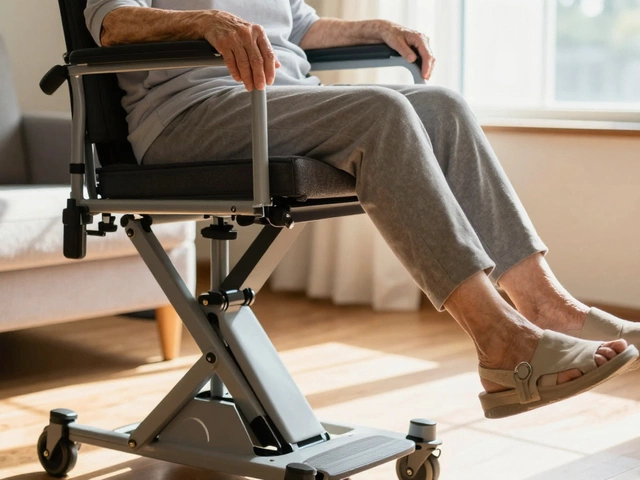Couch Durability Calculator
Enter your couch details to calculate its expected lifespan based on real-world durability factors from our guide.
Expected Lifespan
Score: out of 20
Why Your Couch Lasts This Long
- Frame wobbles or makes popping noises
- Cushions don't bounce back
- Fabric is thinning or stained beyond cleaning
- Sinking too far into the seat
- Arms are cracked or falling off
- Odors after 10+ years
Most people buy a couch thinking it’ll last forever. Then, after three years, the cushions sink like sandbags, the fabric starts pilling, and the frame creaks like an old door. You’re not imagining things - your couch is wearing out faster than it should. But how long couch should last? The answer isn’t a single number. It depends on how it’s made, how you use it, and what you’re willing to spend upfront.
What Determines How Long a Couch Lasts?
A couch isn’t just fabric and foam. It’s a system of parts, and each one has its own lifespan. The frame is the skeleton. The springs and webbing are the muscles. The cushions are the soft tissue. And the fabric? That’s the skin.
High-quality hardwood frames - like kiln-dried oak, maple, or birch - can last 15 to 20 years. But if the frame is made from particleboard, plywood, or softwood, it might start breaking down in under five years. You won’t always see this. The frame hides under the fabric, but you’ll feel it when the couch sags unevenly or leans to one side.
Spring systems matter too. Eight-way hand-tied springs are the gold standard. They hold their shape for decades. Sinuous springs (S-shaped metal coils) are common in mid-range couches and last 10 to 15 years if well-made. But if you see sagging between the seats, the springs are probably worn out.
Cushions are the first to go. High-density foam (1.8 lb/ft³ or higher) lasts longer than low-density foam. Down and feather blends are soft but need fluffing and can flatten in 2-4 years. Synthetic fiber fills are cheaper but break down fast. Memory foam cushions can last 7-10 years if they’re thick enough - but if they’re under 3 inches, they’ll collapse quickly.
What Materials Hold Up Best?
Not all fabrics are created equal. Cotton and linen look nice but wear out fast, especially with pets or kids. Polyester blends are more durable but can look cheap. Leather? It’s tough. Full-grain or top-grain leather lasts 15-25 years with basic care. It cracks if dried out, but conditioned twice a year, it ages beautifully.
Performance fabrics are the quiet winners. Brands like Crypton, Sunbrella, and Revolution offer stain-resistant, fade-resistant, and pet-proof materials. These are common in high-end outdoor furniture, but now they’re inside living rooms too. A couch with performance fabric can survive spills, muddy paws, and 10-hour Netflix binges without looking tired.
Check the rub count - that’s the industry standard for fabric durability. Anything under 15,000 double rubs is for light use. 30,000+ is for heavy traffic. If you have kids, pets, or host gatherings often, aim for 40,000+.
How Often Do People Actually Replace Their Couches?
A 2024 survey by the Furniture Industry Research Association found that the average North American replaces their couch every 7 to 10 years. But that’s an average. Some toss theirs after 3 years because it looks outdated. Others keep the same one for 20+ years.
The real trigger isn’t time - it’s comfort. When the seat depth feels too shallow, the backrest doesn’t support your spine, or you have to rearrange cushions just to sit down, that’s when people start shopping again. Style changes matter less than function. You don’t need a new couch because the color is ‘out.’ You need one when you’re waking up with lower back pain.
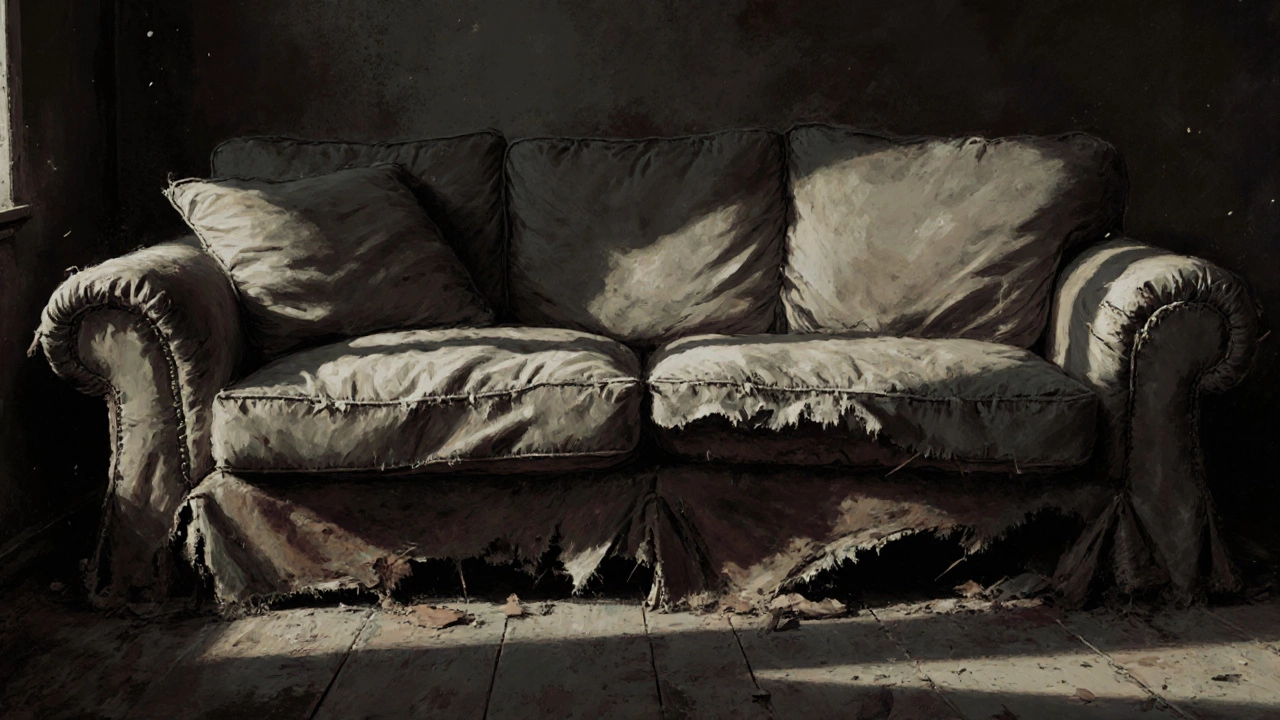
Signs It’s Time to Replace Your Couch
- The frame wobbles or makes loud popping noises when you sit down.
- Cushions stay indented after you get up - no bounce back.
- The fabric is thinning, ripped, or stained beyond cleaning.
- You sink so far in that you have to push yourself up with your arms.
- The arms are cracked, loose, or falling off.
- You’ve had it longer than 10 years and it’s starting to smell like old sweat or pets.
If two or more of these are true, it’s not just old - it’s unhealthy. Poor posture on a bad couch contributes to chronic back pain, hip tightness, and even poor sleep. You’re not being dramatic. You’re being smart.
How to Make Your Couch Last Longer
You don’t have to wait for disaster. A few simple habits can double your couch’s life.
- Rotate cushions every month. Flip them front-to-back and top-to-bottom.
- Vacuum the crevices weekly. Dust and crumbs grind into fabric and foam.
- Use a fabric protector spray every 6 months. It repels spills and reduces fading.
- Keep it away from direct sunlight. UV rays break down fibers and fade colors.
- Don’t sit on the arms. That’s not a footrest - it’s a stress point.
- Get it professionally cleaned every 2 years. Steam cleaning removes deep dirt without damaging foam.
And if you have pets? Get a removable, washable slipcover. It’s cheaper than replacing the whole couch.
Warranties: What They Really Mean
Most couches come with a warranty. But don’t assume it means durability. A 1-year warranty on the frame? That’s a red flag. A 10-year warranty on the frame and springs? That’s a good sign.
Warranties often exclude cushions, fabric, and normal wear. Some brands even void the warranty if you don’t use their specific cleaning products. Read the fine print. A strong warranty means the maker stands behind their build - not just that they’ll send you a coupon for a new cushion.
Look for brands that offer lifetime warranties on frames. They’re rare, but companies like Stickley, Hancock & Moore, and La-Z-Boy’s premium lines do it. You pay more upfront, but you’re buying peace of mind.
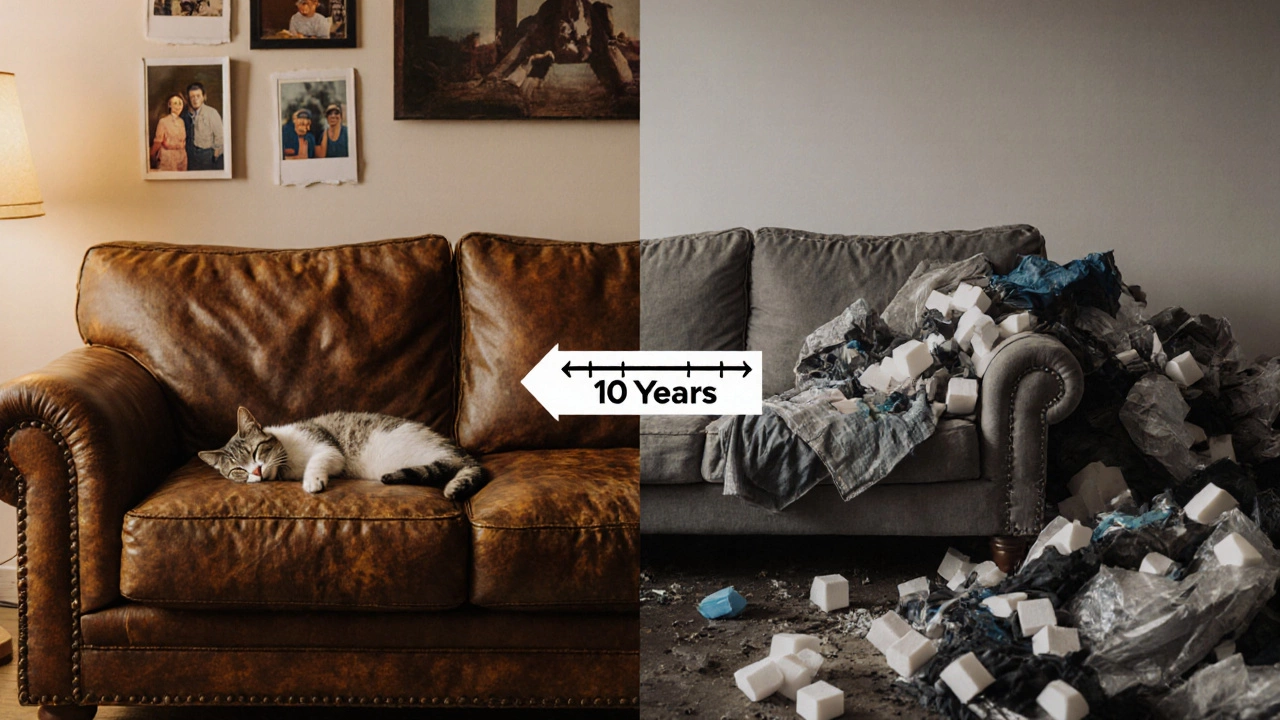
When to Invest - and When to Save
There’s no point spending $5,000 on a couch if you move every 2 years. But if you’re settling in, buying a $2,000 couch made with hardwood and performance fabric is smarter than three $600 couches over 10 years.
Here’s a quick rule: If you sit on your couch 4+ hours a day, spend at least $1,200. If you have kids or pets, go higher - $1,800+. If you use it once a week for movie nights, a $800 couch with decent foam and fabric is fine.
Shop at local furniture makers. They often use better materials than big-box stores. Ask if the frame is kiln-dried. Ask about spring type. Ask if the cushions are removable and replaceable. If they hesitate or give vague answers, walk away.
What Happens to Old Couches?
Over 7 million couches end up in Canadian landfills each year. Most are not recyclable. Foam and fabric are glued together - separating them is nearly impossible.
Don’t just dump yours. Check with your city’s waste management program. Mississauga offers free bulky item pickup. Some charities take couches if they’re clean and undamaged. Reuse centers like The ReStore (run by Habitat for Humanity) accept furniture in good condition. You might even get a tax receipt.
Don’t let your couch become trash. It’s not just waste - it’s a failed investment.
Final Answer: How Long Should a Couch Last?
A well-made couch, used with care, should last 10 to 15 years. With premium materials and maintenance, it can go 20+ years. A cheap couch, used hard, might die in 3 to 5.
Don’t replace it because it’s old. Replace it when it stops working for you. Your back, your comfort, and your wallet will thank you.
Can I fix a sagging couch instead of replacing it?
Yes, but only if the frame is still solid. You can replace the cushions with higher-density foam, add webbing underneath, or install new springs. A professional upholsterer can do this for $300-$700 - cheaper than a new couch. But if the frame is warped or broken, it’s not worth repairing.
Is leather better than fabric for long-term use?
Leather lasts longer than most fabrics - 15 to 25 years with care. It resists stains, doesn’t pill, and gets better with age. But it’s not ideal for homes with pets that scratch or kids who spill juice constantly. Performance fabrics are more forgiving and easier to clean. Choose leather if you want elegance and longevity. Choose performance fabric if you want durability without fuss.
Does the brand matter when buying a durable couch?
Yes, but not because of the logo. Brands like Stickley, Natuzzi, and Roche Bobois use solid wood frames, hand-tied springs, and high-density foam. Big-box stores often use the same suppliers for multiple brands - so you can find the same couch under different labels. Ask where it’s made, what materials are used, and if you can see the frame. A brand name doesn’t guarantee quality - transparency does.
Can I extend my couch’s life with a slipcover?
Absolutely. A well-fitted slipcover protects the original fabric from UV damage, spills, and pet claws. It’s one of the cheapest ways to refresh an old couch. Look for slipcovers made from cotton-linen blends or performance fabrics. Make sure they’re machine washable. You can buy custom ones online or sew your own if you’re handy.
Why do some couches last longer than others even if they cost the same?
It’s all in the details. Two $1,500 couches might look identical, but one could have kiln-dried hardwood and 2.5 lb foam, while the other uses particleboard and 1.5 lb foam. The difference isn’t visible - it’s hidden under the fabric. Always ask for specs: frame material, spring type, foam density, and fabric rub count. If the salesperson doesn’t know, it’s probably not built to last.

